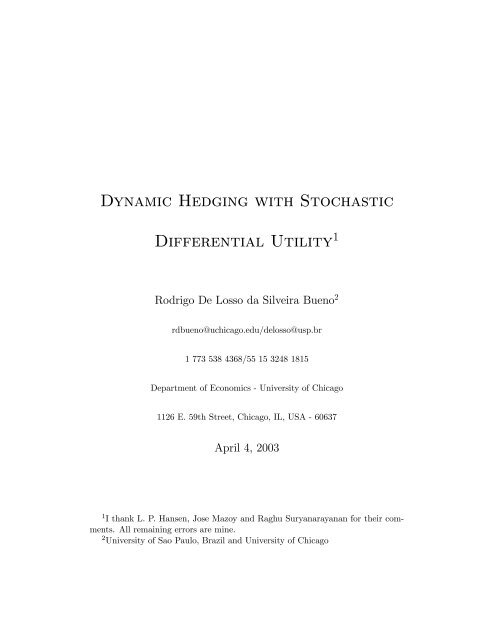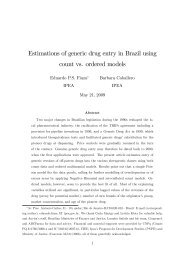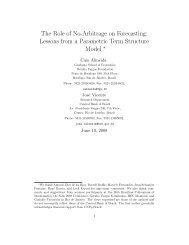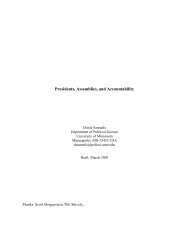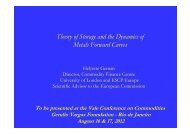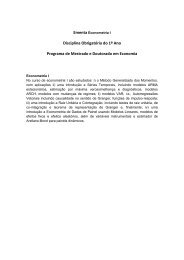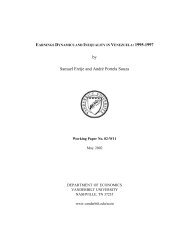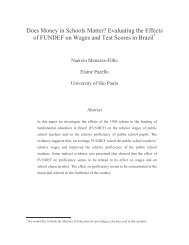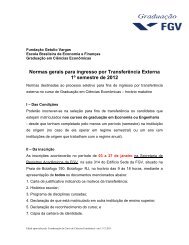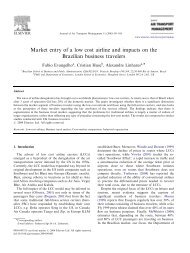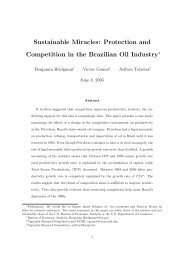Dynamic Hedging with Stochastic Differential Utility
Dynamic Hedging with Stochastic Differential Utility
Dynamic Hedging with Stochastic Differential Utility
Create successful ePaper yourself
Turn your PDF publications into a flip-book with our unique Google optimized e-Paper software.
<strong>Dynamic</strong> <strong>Hedging</strong> <strong>with</strong> <strong>Stochastic</strong><br />
<strong>Differential</strong> <strong>Utility</strong> 1<br />
Rodrigo De Losso da Silveira Bueno 2<br />
rdbueno@uchicago.edu/delosso@usp.br<br />
1 773 538 4368/55 15 3248 1815<br />
Department of Economics - University of Chicago<br />
1126 E. 59th Street, Chicago, IL, USA - 60637<br />
April 4, 2003<br />
1 I thank L. P. Hansen, Jose Mazoy and Raghu Suryanarayanan for their comments.<br />
All remaining errors are mine.<br />
2 University of Sao Paulo, Brazil and University of Chicago
Abstract<br />
In this paper we study the dynamic hedging problem using three different<br />
utility specifications: stochastic differential utility, terminal wealth utility,<br />
and we propose a particular utility transformation connecting both previous<br />
approaches. In all cases, we assume Markovian prices. <strong>Stochastic</strong> differential<br />
utility, SDU, impacts the pure hedging demand ambiguously, but decreases<br />
the pure speculative demand, because risk aversion increases. We also show<br />
that consumption decision is, in some sense, independent of hedging decision.<br />
With terminal wealth utility, we derive a general and compact hedging formula,<br />
which nests as special all cases studied in Duffie and Jackson (1990).<br />
We then show how to obtain their formulas. With the third approach we<br />
find a compact formula for hedging, which makes the second-type utility<br />
framework a particular case, and show that the pure hedging demand is not<br />
impacted by this specification. In addition, <strong>with</strong> CRRA- and CARA-type<br />
utilities, the risk aversion increases and, consequently the pure speculative<br />
demand decreases. If futures price are martingales, then the transformationplaysnoroleindeterminingthehedgingallocation.Wealsoderivethe<br />
relevant Bellman equation for each case, using semigroup techniques.<br />
Keywords: <strong>Stochastic</strong> Control, Recursive <strong>Utility</strong>, <strong>Hedging</strong>, Bellman<br />
Equation<br />
JEL Classification: C61,D92,G11
1 INTRODUCTION<br />
In this paper we aim at studying the optimal futures hedging problem using<br />
a continuous-time setting, stochastic differential utility (Duffie andEpstein,1992),SDU,andassumingMarkovianpricesasinAdlerandDetemple<br />
(1988). Then we extend the model in Duffie and Jackson (1990) - henceforth<br />
referred to as DJ - in three ways. In the first, we maximize the intertemporal<br />
consumption, in the spirit of Ho (1984). The consumption approach<br />
is interesting because in an intertemporal context, the agent is willing to<br />
stabilize the expected consumption stream. In order to perform such a task,<br />
the agent adjusts present consumption to account for investment for future<br />
consumption and holds positions in futures. The latter is called futures hedging<br />
and the former consumption hedging. Recursive utility disentangles risk<br />
aversion from intertemporal substitutability, and therefore it may allow us to<br />
enhance the efficiency of the hedging strategy by means of its less restrictive<br />
structure. Consequently, we think of this approach as a tool which hedgers<br />
may use in order to improve the performance of their futures position, in<br />
such a way that SDU adds some degrees of freedom in a possible empirical<br />
treatment still to be undertaken. However, <strong>with</strong> standard SDU, the formula<br />
that we obtain depends upon the derivatives of the value function, which is<br />
not easy to figure out. Thereby, to solve the optimal hedge, we potentially<br />
have to employ numerical methods.<br />
Afterwards, in the second case, the agent maximizes the terminal wealth,<br />
a usual assumption when we are only worried about a specific futuredate.<br />
Maximizing the utility of the terminal wealth has an advantage of producing<br />
closed formulas for some cases that arise naturally, and, hence, our analysis<br />
1
may be deepened further. As a matter of fact, we are able to produce a<br />
general hedging formula, which nests as special all cases studied in DJ’s<br />
paper. Then we specialize it to compare <strong>with</strong> those obtained by them.<br />
As a consequence of regarding prices as Markov processes, the myopic<br />
hedging problem at each time 1 no longer holds necessarily. Hence, our optimal<br />
futures hedging formulas are not the same as the corresponding static<br />
hedges, nor directly comparable to analogous solutions in discrete-time cases,<br />
as the results in Anderson and Danthine (1981, 1983).<br />
We would like to find some link between both approaches that we have<br />
mentioned. We do this by making a suitable transformation on the Terminal<br />
Value-type utility. Then we take advantage of the compact formulas that<br />
it produces and see explicitly what effect the SDU specification exerts on<br />
the standard model, that is, we introduce the certainty equivalent machinery<br />
in the Hamilton-Jacobi-Bellman equation, HJB, of the terminal value utility<br />
and study what effects this causes on the optimal hedge ratio. The particular<br />
concave transformation that we employ is the connection between SDU and<br />
Terminal <strong>Utility</strong>. This adds some degrees of freedom and may potentially improve<br />
the hedging strategy. The main advantage of this specification, hence,<br />
is to make DJ’s model a special case, and to allow us to derive interesting<br />
and neat results.<br />
Our model is similar to DJ in several aspects: spot and futures prices<br />
are vector diffusion processes; a hedge is a vector stochastic process which<br />
specifies a futures position in each futures market; and the hedging profits<br />
1 Myopic hedging at each time means that an agent is hedging only local changes in<br />
wealth. Further discussion can be found in Adler and Detemple (1988) and the references<br />
therein.<br />
2
and losses are marked to market in an interest-paying margin account. The<br />
optimal hedge ratio will be obtained by maximizing the expected utility,<br />
composed by a committed portfolio of spot markets and the accumulated<br />
value of the margin account.<br />
We reserve the appendix to derive the relevant HJB equations, taking<br />
advantage of the semigroup approach.<br />
The paper is organized as follows: in Section 2, we present the primitives<br />
of our model; in Section 3, we derive the optimal hedge under SDU; in Section<br />
4, we derive the optimal hedge ratio maximizing only the terminal utility and<br />
make some specializations to compare our results <strong>with</strong> some of those obtained<br />
by DJ and also previously in the paper; in Section 5, we derive the optimal<br />
hedge ratio under the proposed utility transformation and compare <strong>with</strong> our<br />
previous results; then, in Section 6, we conclude. In the appendix, we discuss<br />
how to obtain the relevant HJB equations; we provide some explanations<br />
about the differential utility, and also about some mathematical concepts<br />
thatweusetoderivetheoptimalhedge.<br />
2 THE MODEL<br />
As mentioned earlier, our model is closely similar to DJ’s, because we consider<br />
an agent choosing a future trading strategy to maximize the expected utility<br />
of consumption from t toafuturetimeT ∈ R + ∪∞, according to the following<br />
setup.<br />
1. Let B = ¡ B 1 ,B 2 ,... ,B N¢ 0<br />
denote a Standard Brownian Motion in<br />
R N<br />
which is a martingale <strong>with</strong> respect to the agent’s filtered proba-<br />
3
ility space 2 . We also assume throughout the paper that probabilistic<br />
statements are in the context of this filtered probability space.<br />
2. V denotes the space of predictable square-integrable processes 3 ,such<br />
that<br />
½<br />
·Z t<br />
V ≡ predictable υ :[0,T] × Ω → R ¯<br />
¯E<br />
0<br />
¸<br />
¾<br />
υ 2 sds < ∞,t∈ [0,T] ,<br />
where Ω is the state space, and predictable means measurable <strong>with</strong> respect<br />
to the σ-algebra generated by left-continuous processes adapted<br />
to the agent’s filtration, that is, υ t depends only on information available<br />
up to time t.<br />
3. There exist M assets to be hedged, whose value is described by an<br />
M-dimensional Markov process S, <strong>with</strong> the stochastic differential representation<br />
dS t = µ t (S t )dt + σ t (S t )dB t , (1)<br />
where µ is M-dimensional, σ is (M × N)-dimensional and µ m ∈ V and<br />
σ mn ∈ V for all m and n (hence, the Markov process S is well defined) 4 .<br />
4. There are K futures contracts available for trade at each instant of<br />
2 ” 0 ” indicates transpose, or differentiation when there is only one argument in the<br />
function.<br />
3 If T = ∞, then the square integrability condition changes to E £R ∞<br />
e βt υ 2 0 sds ¤ < ∞,<br />
where β is a constant characterized in Appendix C of Duffie and Epstein (1992).<br />
4 Henceforth, we omit the dependence of the parameters on S t for simplicity.<br />
4
time, whose prices are given by a K-dimensional Ito process F <strong>with</strong><br />
the stochastic differential representation<br />
dF t = m t (F t )dt + υ t (F t )dB t , (2)<br />
where m k ∈ V and υ kn ∈ V for all k and n 5 .<br />
5. A futures position is taken by marking to market a margin account<br />
accordingtoaK-dimensional process θ = ¡ θ 1 , θ 2 ,... ,θ K¢ 0<br />
,<strong>with</strong>the<br />
property that θ 0 m as well as each element of θ 0 υ belong to V . The<br />
space Θ of all such futures position strategies is then described by<br />
Θ = {θ |θ 0 m ∈ V and θ 0 υ n ∈ V,∀n} .<br />
6. At time t the position θ t in the K contracts is credited <strong>with</strong> any gains<br />
or losses incurred by futures price changes, and the credits (or debits)<br />
are added to the agent’s margin account. Thus, the margin account’s<br />
current value, denoted by Xt θ ,iscredited<strong>with</strong>interestattheconstant<br />
continuously compounding rate r ≥ 0. Furthermore, we assume that<br />
losses bringing the account to a negative level are covered by borrowing<br />
at the same interest rate, and ignore transactions costs and other<br />
institutional features. In a continuous-time model, the margin account<br />
then has the form<br />
X θ t =<br />
Z t<br />
0<br />
e r(t−s) θ 0 sdF s , (3)<br />
5 Idem <strong>with</strong> respect to F t .<br />
5
indicating that the ’increment’ θ 0 sdF s to the margin account at time<br />
s is re-invested at the rate r, implying a corresponding increment of<br />
e r(t−s) θ 0 sdF s to the margin account by time t. Itsequivalentstochastic<br />
differential equation applying Ito’s Lemma is<br />
dX θ t = ¡ rX θ t + θ 0 tm t<br />
¢<br />
dt + θ<br />
0<br />
tυ t dB t . (4)<br />
7. Let π t ∈ R M be a bounded measurable function standing for the agent<br />
spot commitment. For simplicity, we also assume that the agent does<br />
not invest in any risky asset. Hence, the total wealth of the agent at<br />
time t, given a futures position strategy θ, isthenWt θ ,whereW θ is the<br />
Itoprocesshavingthestochasticdifferential representation<br />
dW θ<br />
t = π 0 tdS t + dX θ t − c t dt, (5)<br />
where c t ∈ V is the consumption rate at time t.<br />
8. Preferences of the agent over wealth at time t are given by the stochastic<br />
differential utility 6 U : V → R, whose ”aggregator”, (f,k), is defined<br />
as f : R D × R → R, and the variance multiplier, k, ask : R → R.<br />
We define f to be regular, meaning that f is continuous, Lipschitz in<br />
utility, and satisfies a growth condition in consumption 7 . In addition,<br />
we assume that f is increasing and concave in consumption 8 .Consider<br />
6 More details about SDU are given in the appendix B<br />
7 More details about the meaning of these concepts, see DJ and Duffie andEpstein<br />
(1992, p. 366).<br />
8 Then, we can apply freely Propositions 3 (monotonicity) and 5 (concavity) of Duffie<br />
and Epstein (1992).<br />
6
the von Newmann-Morgenstern index, h, which is continuous, strictly<br />
increasing, and satisfies a growth condition, implying it is integrable.<br />
It is called the risk-adjustment function and measures the local risk<br />
aversion. Because we also adopt assumption 2 in Duffie andEpstein<br />
(1992), we obtain k(J) = h00 (J)<br />
< 0. This leaves the problem<br />
h 0 (J)<br />
Z T<br />
max E t<br />
·f (c s ,J(z s )) + 1<br />
θ∈Θ,c∈V<br />
s≥t<br />
2 k (J (z s)) Jz 0 s<br />
ΣJ zs¸<br />
ds, (6)<br />
<strong>with</strong> δ > 0 being the subjective discount rate 9 .<br />
With this model in mind, we can define the optimal futures position.<br />
Definition 1 A futures position strategy θ is definedtobeoptimalifitsolves<br />
6.<br />
3 STOCHASTIC DIFFERENTIAL UTILITY<br />
In this section we derive directly the optimal futures hedging, under Markovian<br />
prices and stochastic differential utility.<br />
Proposition 1 The optimal futures position strategy is θ SDU ,where<br />
(J ww + J wx )+k(J)(Jw 2 + J w J x )<br />
t = −<br />
(J ww +2J wx + J xx )+k(J)(Jw 2 +2J w J x + Jx) × 2<br />
θ SDU<br />
(υ t υ 0 t) −1 ·υ t σ 0 tπ t +<br />
J w + J x<br />
(J ww + J wx )+k(J)(J 2 w + J w J x ) m t<br />
¸<br />
. (7)<br />
9 Without recursive utility, f (c s ,J(z s )) = u (c s ) − δJ (z s ), and k(J) =0.<br />
7
Proof. Let W θt define the wealth process that would obtain starting at<br />
time t and<strong>with</strong>futuresstrategyθ, translating time parameters back t time<br />
units to time 0, or<br />
dW θt<br />
s = a t+s ds + b 0 t+sdB s ,<br />
where a t+s = rXs θt +π 0 tµ t+s +θ 0 t+sm t+s −c t+s ,andb t+s = σ 0 t+sπ t +υ 0 t+sθ t+s .<br />
Similarly, let X θt be the t-translate of the process X defined by<br />
dX θt<br />
s = α t+s ds + β 0 t+sdB s ,<br />
where α t+s = rXs θt + θ 0 t+sm t+s ,andβ t+s = υ 0 t+sθ t+s .<br />
Define the value function J : R 2 → R by<br />
J (z t )=<br />
Z T<br />
max E t<br />
·f (c s ,J(z s )) + 1<br />
θ∈Θ,c∈V<br />
s≥t<br />
2 k (J (z s)) Jz 0 s<br />
ΣJ zs¸<br />
ds,<br />
and let J b : R 2 → R be defined by J b (z t )=E t [U (c)], wherez =(w, x),<br />
³<br />
´<br />
Z θSDU t<br />
0 ≡ W θSDU t<br />
0 ,X θSDU t<br />
0 =(w, x), <strong>with</strong> the boundary condition as J b (z T )=<br />
0 10 .<br />
Notice that:<br />
dZ t = µ zt<br />
dt + Λ zt dB t ,<br />
where µ zt<br />
=(a t , α t ) 0 ,andΛ zt =(b t , β t ) 0 .<br />
The HJB equation <strong>with</strong> recursive utility is given by u(c t ) − δJ + A d J +<br />
10 In special situations, we may vary from the convention of having zero terminal utility<br />
(see Duffie and Epstein, 1992).<br />
8
1<br />
k(J) ¡ ¢<br />
J 0 2 z t<br />
ΣJ zt =0,whereAd is the infinitesimal generator 11 .<br />
Then, using the HJB equation we get:<br />
δJ = sup {u(c t )+J w a t + J x α t +<br />
θ∈R k ,c∈V<br />
+ 1 2 tr £ J ww b t b 0 t +2J wx β t b 0 t + J xx β t β 0 t + k(J)ΣJ zt J 0 z t<br />
¤ ¾ .<br />
Two observations are in order here. First, this program can be split into<br />
two independent decisions:<br />
sup (u(c t ) − J w c t ) , and<br />
c∈V<br />
© ¡ ¢<br />
sup Jw rX<br />
θt<br />
s + π 0 tµ t+s + θ 0 t+sm t+s + Jx α t +<br />
θ∈R k<br />
+ 1 2 tr £ J ww b t b 0 t +2J wx β t b 0 t + J xx β t β 0 t + k(J)ΣJ zt J 0 z t<br />
¤ ¾ .<br />
Second, notice that:<br />
a. b 0 tb t =(σ 0 tπ t + υ 0 tθ t ) 0 (σ 0 tπ t + υ 0 tθ t )=π 0 tσ t σ 0 tπ t +2π 0 tσ t υ 0 tθ t + θ 0 tυ t υ 0 tθ t ⇒<br />
∂b 0 t b t<br />
∂θ t<br />
=2υ t σ 0 tπ t +2υ t υ 0 tθ t ;<br />
b. b 0 tβ t =(σ 0 tπ + υ 0 tθ t ) 0 υ 0 tθ t = π 0 tσ t υ 0 tθ t + θ 0 tυ t υ 0 tθ t ⇒ ∂b0 t β t<br />
∂θ t<br />
= υ t σ 0 tπ t +<br />
2υ t υ 0 tθ t ;<br />
c. β 0 tβ t = θ 0 tυ t υ 0 tθ t ⇒ ∂β0 t β t<br />
∂θ t<br />
=2υ t υ 0 tθ t .<br />
11 See appendix for details.<br />
9
Then it follows from the first order conditions for θ that:<br />
0 = (J w + J x ) m t + ¡ J ww + k(J)J 2 w¢<br />
(υt σ 0 tπ t + υ t υ 0 tθ t )+<br />
(J wx + k(J)J x J w )(υ t σ 0 tπ t +2υ t υ 0 tθ t )+ ¡ J xx + k(J)J 2 x¢<br />
υt υ 0 tθ t .<br />
Collect terms, and the result follows.<br />
The characterization of the optimal strategy is in terms of the derivatives<br />
of the value function as in Breeden (1984), Ho (1984), and Adler and De-<br />
Temple (1988); thereby, potentially we may have to solve this equation by<br />
numerical methods. We can see that the optimal consumption is determined<br />
independently of the hedging decisions. This is a result similar to Ho (1984).<br />
Observe that the drift of the spot prices does not affect explicitly the futures<br />
optimal hedging. It may affect through other channels, however, as for instance,<br />
the derivatives of the Bellman equation. The utility parameters, the<br />
volatility parameters of the prices and the drift of the futures prices affect<br />
the optimal strategy in an evident way. Of course, it is easy to notice that<br />
if k(J) = 0, then we have optimal futures hedging formula for the standard<br />
additive utility specification 12 .<br />
12 See also the hedging formula in Section 4. This happens because of the independence<br />
between consumption and hedging decision.<br />
10
Under our assumptions about the utility and the aggregator, at the optimal,<br />
the first multiplicative term is positive 13 :<br />
A t ≡<br />
⎛<br />
⎛ ⎞ ⎛ ⎞<br />
−<br />
−<br />
+<br />
z }| { z}|{ z }| {<br />
⎝J ww + J wx<br />
⎠ + k(J) ⎝J w 2 + J w J x<br />
⎠<br />
⎞<br />
⎝J ww +2J wx + J | {z xx<br />
⎠ + k(J) ⎝J }<br />
w 2 +2J w J x + J 2 ⎠<br />
x<br />
| {z }<br />
−<br />
+<br />
⎛<br />
⎞<br />
> 0.<br />
Given we do not know the functional form the value function, it is difficult<br />
to say if A is greater or less than that under standard utility. However, we<br />
can say that its sign does not change under SDU.<br />
In addition, the term that multiplies m t is negative:<br />
−R −1<br />
t<br />
≡<br />
⎛<br />
+<br />
z }| {<br />
J w + J<br />
⎞ x<br />
⎛<br />
⎞<br />
⎝J ww + J | {z wx<br />
⎠ + k(J) ⎝J }<br />
w 2 + J<br />
|{z}<br />
w J x<br />
⎠<br />
| {z }<br />
−<br />
−<br />
+<br />
< 0.<br />
We interpret R as being an extended version of the risk aversion coefficient<br />
because it includes terms like J x and J wx . The numerator is a measure of<br />
the global concavity of the value function plus the term originated from the<br />
SDU approach; and the denominator stands for the global curvature of the<br />
value function 14 . If the value function becomes more concave, either because<br />
13 From the first order conditions 0 0.<br />
14 With Terminal <strong>Utility</strong>, as we will see later, this term becomes the standard coefficient<br />
of risk aversion − Jww<br />
J w<br />
.<br />
11
of the wealth or because the margin account, R increases as in the standard<br />
case. Furthermore, notice that the SDU utility adds a penalty through the<br />
presence of the additional term in the numerator: If the curvature of the<br />
value function increases, both numerator and denominator increase, making<br />
the net effect unknown (in the standard case, risk aversion would decrease.)<br />
The sign of R does not change under SDU. In short, the global net effect<br />
is that the extended risk aversion increases because of the presence of the<br />
mentioned term in the denominator. This is, of course, an implication from<br />
Proposition 6 (Comparative Risk Aversion) in Duffie and Epstein (1992).<br />
With this in mind, Duffie (1989) arguably calls the first term between<br />
brackets in equation 7 as the pure hedge demand, andthesecondtermas<br />
the pure speculative demand 15 . The term pure hedge demand comes from a<br />
uniperiod model, where we want only to minimize risks, that is, we minimize<br />
the variance of our position, <strong>with</strong>out preoccupations <strong>with</strong> the return. In this<br />
case, θ t =(υ t υ 0 t) −1 υ t σ 0 tπ t (see additional discussion in Section 4.1).<br />
Ifthespotcommitmentiszeroattimet, the hedger may still be willing to<br />
buy futures through the pure speculative demand term. This also would be so<br />
if covariance between spot and futures prices were null - υ t is orthogonal to σ t<br />
-, meaning that futures contracts do not provide any protection against spot<br />
price fluctuations 16 . Also, if the covariance between futures and spot prices<br />
increases in absolute value, one increases the position under hedge, since the<br />
role of protecting against undesirable fluctuation in prices increases.<br />
15 Adler and Detemple (1988) call them, respectively, as the Merton/Breeden informationally<br />
based hedging component, and as the mean-variance component.<br />
16 Here we are not taking into account equilibrium concerns.<br />
12
Looking at the second part inside the brackets, the formula shows that<br />
themultiplicativetermofm t has increased <strong>with</strong> the extra term in the denominator,<br />
for the entire expression is negative as we have already shown.<br />
Thus, its absolute value decreases. Therefore the contribution of the pure<br />
speculative demand to the optimal hedge strategy decreases <strong>with</strong> recursive<br />
utility. If m t = 0, however, the solution does not depend explicitly on the<br />
drift of futures prices, but differently from DJ, it depends on the parameters<br />
of the recursive utility through k(J) and the other derivatives.<br />
4 TERMINAL WEALTH<br />
In this section, we practically hold the same model as before. However, we<br />
make a fundamental modification by maximizing the utility of the terminal<br />
wealth, instead of the consumption over time. As a consequence, we consider<br />
here a finite time, T . We also make a simplifying assumption by considering<br />
thespotcommitmentconstantovertime. Thismakesourmodelidentical<br />
to DJ’s, except that our prices are Markovian. This assumption about the<br />
prices is not new; Adler and Detemple (1988) have assumed it in a model<br />
constructed to solve a similar problem. Formally, we have:<br />
1. The agent is committed to receiving the value at time T of a position<br />
in these assets represented by a fixed portfolio π ∈ R M ,leavingthe<br />
terminal value π 0 S T . Hence, the total wealth of the agent at time T ,<br />
given a futures position strategy θ, isthenWT θ ,whereW θ is the Ito<br />
13
process having the stochastic differential representation<br />
dW θ<br />
t = π 0 dS t + dX θ t . (8)<br />
2. Preferences of the agent over wealth at time T are given by von Newman-<br />
Morgenstern utility function U : R → R, which is monotonic, twice<br />
continuously differentiable, strictly concave, <strong>with</strong> U 0 and U 00 each satisfying<br />
a (linear) growth condition. This leaves the problem<br />
max E £ ¡ ¢¤<br />
t U W<br />
θ<br />
T . (9)<br />
θ∈Θ<br />
Of course the optimal position now is the one that maximizes statement<br />
9. Then we can state the proposition:<br />
Proposition 2 The optimal futures position strategy, by maximizing the terminal<br />
utility, is θ TV , where<br />
θ TV<br />
t<br />
·<br />
(J ww + J wx )<br />
= −<br />
(J ww +2J wx + J xx ) (υ tυ 0 t) −1 υ t σ 0 tπ t +<br />
J ¸<br />
w + J x<br />
(J ww + J wx ) m t<br />
(10)<br />
Proof. Theproofisthesameastheonepresentedinthelastsection<br />
except that π t+s = π, c t+s =0, ∀ s, t ≥ 0, andwedefine the value function<br />
J : R 2 → R by<br />
J (z t )=max<br />
θ∈Θ E £ U ¡ W θt<br />
T −t¢¤<br />
.<br />
Since we are maximizing as expected utility at a future date T , the HJB<br />
14
equation of this case is a little bit different, and it is given by A d J =0 17 .<br />
In this case, we define the boundary condition as bJ (z T )=U(w).<br />
Notice that we are only worried about the local mean effect, because<br />
of our interest in the terminal value of the wealth at the maturity of the<br />
contract. Also, observe the similarity of this expression <strong>with</strong> that obtained<br />
under SDU, had we assumed k(J) =0.<br />
The qualitative analysis we provided before regarding the formula under<br />
SDU holds here <strong>with</strong>out modification, thus we do not repeat it.<br />
The formula can be compacted further! In order to do that, let us state<br />
animportantresultofourmodel:<br />
Proposition 3 The net return of the variation in the final wealth given a<br />
variation in the initial wealth is equal to the variation in the final wealth<br />
given a variation in the initial margin account. Formally,<br />
{exp [r (T − t)] − 1}<br />
∂W<br />
θt<br />
T −t<br />
∂w<br />
Proof. Itô’s lemma on equation 4 gives us:<br />
X θ t = X θ 0 +<br />
Z t<br />
Differentiate X θ t <strong>with</strong> respect to X θ 0:<br />
0<br />
∂X θ t<br />
∂X θ 0<br />
θt<br />
∂W<br />
= T −t<br />
∂x .<br />
Z<br />
¡ ¢ t<br />
rX<br />
θ<br />
s + θ 0 sm s ds + θ 0 sυ s dB s .<br />
Z t<br />
∂Xs<br />
θ =1+r ds.<br />
0 ∂X0<br />
θ<br />
0<br />
17 See appendix C or Krylov (1980) for a proof.<br />
15
Define y s ≡ ∂Xθ s<br />
. Then the expression is an ordinary differential equation,<br />
∂X0<br />
θ<br />
whose solution is given by<br />
y t = y 0 e rt ,y 0 =1.<br />
Hence<br />
∂X θ T −t<br />
∂X θ 0<br />
= e r(T −t) .<br />
By Itô’s lemma again on equation 8:<br />
Z T −t<br />
WT θt<br />
−t = W0 θt +<br />
= W θt<br />
0 +<br />
0<br />
Z T −t<br />
0<br />
a t+s ds +<br />
π 0 µ t+s ds +<br />
Z T −t<br />
0<br />
Z T −t<br />
0<br />
b 0 t+sdB s =<br />
= W0 θt + π 0 (S T −t − S 0 )+XT θt<br />
−t − X0 θt .<br />
¡<br />
σ<br />
0<br />
t+s π ¢0 dB s + X θt<br />
T −t − X θt<br />
0 =<br />
Consequently the result follows.<br />
Proposition 3 says that a positive variation in the initial wealth implies<br />
a positive variation in the final wealth, and hence, in the value function, as<br />
we will see soon. Similar argument can be stated <strong>with</strong> respect to the initial<br />
position in the margin account. In the proof, notice that an increase in the<br />
initial margin account amounts to a gross return growth in the final margin<br />
during the period considered.<br />
This result does not rely on the utility assumptions, but only on the<br />
budget constraint. Consequently this result holds whether we are at the<br />
optimal point or not.<br />
16
The next statement is a direct consequence from this proposition.<br />
makes a connection between the derivatives of the value function:<br />
It<br />
Corollary 1 Given the assumptions about the utility and budget constraint,<br />
then the following equality holds:<br />
{exp [r (T − t)] − 1} J w = J x .<br />
Proof. First observe that<br />
J(z t )=E £ U ¡ ¢¤<br />
WT θt<br />
−t<br />
Differentiate inside the expectation 18 :<br />
0 < ∂J ·<br />
∂w = E U ¡ 0 WT θt<br />
−t<br />
0 < ∂J ·<br />
∂x = E U ¡ 0 WT θt<br />
−t<br />
Apply Proposition 3 and the result follows.<br />
¢ ∂W θt<br />
T −t<br />
∂w<br />
¢ ∂W θt<br />
T −t<br />
∂x<br />
¸<br />
;<br />
¸<br />
.<br />
now:<br />
From this Corollary 1, it arises another interesting corollary that is stated<br />
Corollary 2 The following equality holds:<br />
{exp [r (T − t)] − 1} 2 J ww = {exp [r (T − t)] − 1} J wx = J xx .<br />
18 See appendix in DJ, which states the sufficient conditions for differentiation inside<br />
the expectation. These conditions are met here, because of our assumptions on the utility<br />
function.<br />
17
Proof. Differentiate inside the expectation again:<br />
"<br />
∂ 2 J<br />
= E U ¡ 00 W θt<br />
∂w 2 T −t<br />
"<br />
∂ 2 J<br />
∂x 2 = E<br />
U 00 ¡ W θt<br />
T −t<br />
·<br />
∂ 2 J<br />
∂w∂x = E U ¡ 00 WT θt<br />
−t<br />
¢ µ ∂W θt<br />
T −t<br />
∂w<br />
¢ µ ∂W θt<br />
¢ ∂W θt<br />
T −t<br />
∂x<br />
T −t<br />
∂w<br />
2<br />
+ U ¡ #<br />
¢ 0 WT θt ∂ 2 WT θt<br />
−t<br />
−t<br />
∂w 2<br />
2<br />
+ U ¡ #<br />
¢ 0 WT θt ∂ 2 WT θt<br />
−t<br />
−t ;<br />
∂x 2<br />
∂WT θt<br />
−t<br />
+ U ¡ ¢ 0 WT θt ∂ 2 WT θt<br />
−t<br />
−t<br />
∂x<br />
∂w∂x<br />
Since all the terms that multiply U ¡ 0 WT −t¢ θt are zero, the result follows by<br />
applying Proposition 3.<br />
;<br />
¸<br />
.<br />
Observe that all second derivatives are negative, since U ¡ WT −t¢ θt is assumed<br />
concave.<br />
Now if we replace the relationships that we obtained in the optimal hedging<br />
equation, we get the following more compact hedge ratio:<br />
Proposition 4 Given our assumption on the budget constraint and utility,<br />
the optimal hedging ratio is given by<br />
θ TV<br />
t = − exp [−r (T − t)] (υ t υ 0 t) −1 ·<br />
υ t σ 0 tπ + J w<br />
J ww<br />
m t¸<br />
. (11)<br />
Proof. Replace terms.<br />
The main discovery is that the first and big term outside the brackets<br />
reduces to a deterministic expression, which does not depend upon the form<br />
of the value function. Also, adding a discount factor in the model would<br />
change the HJB equation accordingly, but would not have effects on the<br />
18
optimal hedging. 19<br />
In order to sharpen further our analysis, we make some simplifying assumptions<br />
in the next subsections, and show how our results are related to<br />
DJ’s.<br />
4.1 MARTINGALES FUTURES PRICES - m t =0<br />
Our first special case occurs when the drift of the futures price is identically<br />
equal to zero. This also happens in 4 out of the 5 cases studied in DJ.<br />
Proposition 5 Under our assumptions coupled <strong>with</strong> m t =0,theoptimal<br />
futures position strategy is θ TV ,where<br />
θ TV<br />
t = −e −r(T −t) (υ t υ 0 t) −1 υ t σ 0 tπ. (12)<br />
This result is very similar to cases 1, 3 and 4 in DJ, where they assume<br />
in all of them martingales futures prices. In their case 1, in addition, they<br />
assume Gaussian prices; case 3, mean-variance preferences; and case 4 lognormal<br />
spot prices and mean-variance utility. Here, we obtain their results<br />
under more general assumptions. The bad news is that, if m t = 0, the utility<br />
parameters play no role in the formula. The explanation given by DJ is that<br />
the demand for futures is based only on the hedge they provide, in such a<br />
way that futures are only used to control ’noise’ in the portfolio process. Still<br />
quoting DJ, ”the optimal manner of doing so depends solely on the structure<br />
of the ’noise’ in the price process, not on the structure of the utility, nor on<br />
the drift of the assets’ price processes.”<br />
19 In Appendix D, Remark, we discuss more deeply this option.<br />
19
In particular, let us see what happens if we specify martingale futures<br />
price and log-normally distributed spot prices. This is a very special case,<br />
and to make it tractable, assume for the m-th spot price:<br />
dS m t<br />
= g m t S m t dt + S m t h m0<br />
t dB t .<br />
In addition, to make this process log-normally distributed, we must impose<br />
gt m and h m t deterministic, where gt m :[0,T] → R and h m t :[0,T] → R N<br />
are bounded measurable functions.<br />
Proposition 6 Under martingale futures prices and log-normally distributed<br />
spot prices, the optimal hedge ratio is<br />
θ TV<br />
t = −e −r(T −t) (υ t υ 0 t) −1 υ t H 0 tπ, (13)<br />
where H t is the M×N matrix whose m th row is St<br />
m<br />
Proof. See DJ.<br />
h R T<br />
exp<br />
t<br />
¡ ¢ i<br />
g<br />
m<br />
s − 1 2 hm0 s h m s ds h m0<br />
t .<br />
4.2 EXPONENTIAL UTILITY - m t 6=0<br />
Supposing that we have an exponential utility is to assume u(w) =−e −γw ,<br />
where γ > 0 is a constant measure of risk aversion. As it is well known, this<br />
kind of utility is often used in continuous-time investment studies.<br />
Proposition 7 Under exponential utility, the optimal futures position strategy<br />
is θ ∗ ,where<br />
θ ∗ t = −e −r(T −t) (υ t υ 0 t)<br />
·υ −1 t σ 0 tπ − 1 ¸<br />
γ m t . (14)<br />
20
Proof. Observe that<br />
·<br />
J w = −γE t U ¡ ¢<br />
W θ∗ t<br />
∂W θ∗ t<br />
T −t<br />
T −t<br />
∂w<br />
"<br />
J ww = γE t<br />
γU ¡ W θ∗ t<br />
T −t<br />
¢ µ ∂W θ∗ t<br />
T −t<br />
∂w<br />
¸<br />
; and<br />
2<br />
− U ¡ #<br />
¢<br />
W θ∗ t<br />
∂ 2 W θ∗ t<br />
T −t<br />
T −t .<br />
∂w 2<br />
Since ∂W θ∗ t<br />
T −t<br />
∂w<br />
=1, the result is immediate.<br />
This is the second-case result in DJ holds as expected. Here it is easy to<br />
see that if the risk aversion increases, the pure speculative demand on the<br />
optimal hedge decreases.<br />
We could consider other commonly used utility functions, such as power<br />
and quadratic functions. But, then, we must deal <strong>with</strong> two problems. First,<br />
for example, power functions do not admit negative values for wealth. Second,<br />
and more practical, in such cases we would have to use numerical methods<br />
to find the optimal hedge, because the expected wealth that would appear<br />
at the RHS depends on the optimal hedging strategy.<br />
We conclude this subsection just recalling that a combination of the assumptions<br />
derived individually could be done in order to obtain a more complete<br />
optimal hedging strategy.<br />
21
4.3 EQUILIBRIUM<br />
Assume exponential utility, such that u i (w) =−e −γ i w stands for the agent’s<br />
Von Newmann-Morgenstern utility for terminal wealth 20 . Then, we obtain:<br />
θ ∗ it = −e −r(T i−t) (υ t υ 0 t) −1 ·<br />
υ t σ 0 tπ it − 1 γ i<br />
m t¸<br />
,<br />
where T i represents the terminal date of agent i.<br />
Market clearing, P I<br />
i=1 θ it =0,impliesthat:<br />
m t = υ t σ 0 t<br />
P I<br />
i=1 e−r(T i−t) π it<br />
P I<br />
i=1<br />
e −r(T i −t)<br />
γ i<br />
P I<br />
= υ t σ 0 i=1 ω itπ it<br />
t P I<br />
, (15)<br />
ω it<br />
i=1 γ i<br />
where ω it ≡<br />
e−r(T i −t)<br />
P Ii=1<br />
e −r(T i −t) .<br />
First, m t is proportional to each individual spot position, whose weights<br />
are given by ω i . If the covariance is high, that means that the futures contracts<br />
provide a good hedge, increasing the demand for hedging. Finally m t<br />
is proportional to the risk aversion of investors. Higher levels of risk aversion<br />
correspond to higher m t , that is, an increasing in the pure speculative<br />
demand.<br />
Sufficient conditions for having m t =0are: (a) P I<br />
i=1 ω itπ it =0,that<br />
is, there is no excess demand for hedging; (b) υ t σ 0 t =0,inwhichcasethe<br />
futures provide no hedge; or (c) γ i =0forsomeagenti. In case (a) agents<br />
can costlessly insure themselves since there exists always someone who desires<br />
to take an opposite position, and then speculators are unnecessary in this<br />
market.<br />
20 This section is closely similar to section 4 in DJ.<br />
22
And substituting this expression in the hedge ratio, we get:<br />
" P #<br />
I<br />
θ ∗ jt = −e −r(Tj−t) (υ t υ 0 t) −1 υ t σ 0 i=1<br />
t π jt −<br />
ω itπ it<br />
P<br />
γ I<br />
.<br />
ω it<br />
j i=1 γ i<br />
5 CONNECTING SDU AND TERMINAL<br />
WEALTH<br />
We would like to find some link between both approaches that we have been<br />
studying. We may do this by making a suitable transformation on the Terminal<br />
Value-type utility.<br />
We might then take advantage of the compact<br />
formulas generated by the second-type utility and explicitly see what effect<br />
the SDU model exerts on the optimal hedge ratio. The effect of the SDU<br />
on the hedge ratio comes only from the certainty equivalent machinery. For<br />
this purpose we make a particular concave transformation of the terminal<br />
value-type utility. Formally, then, we have:<br />
1. Preferences of the agent over wealth at time t aregivenbytheutility<br />
U : V → R, defined as 21<br />
max<br />
¡ £ ¡ ¡ ¢¢¤¢<br />
θ∈Θ h−1 E t h U W<br />
θt<br />
T .<br />
21 An alternative, and equivalent, characterization would be to maximize J(z t ) =<br />
£ ¡ ¢¤<br />
E t U W<br />
θt<br />
T +<br />
1<br />
2 E R T<br />
t s≥t k (J (z s)) Jz 0 s<br />
ΣJ zs ds (see appendix). This would generate the<br />
same HJB equation, and hence the same evolution of the value function. However, additional<br />
derivations that we make later on, if started from this definition, would be messier.<br />
This is the reason that we have chosen that definition in the main text.<br />
23
The practical advantage is to produce neat formulas for our problem. In<br />
theoretical grounds we are assuming that we can add the certainty equivalent<br />
in the HJB equation when we are maximizing the utility of the final wealth.<br />
Our procedure lies in the remarkable consequence of the forward-looking<br />
nature of the Bellman equation under SDU, dispensing <strong>with</strong> state variables<br />
reflecting past decisions (see Duffie and Epstein, p. 373, 1992).<br />
Then, the optimal hedging ratio is given by:<br />
Proposition 8 The optimal futures position strategy is θ TWSDU , where<br />
(J ww + J wx )+k(J)(Jw 2 + J w J x )<br />
t = −<br />
(J ww +2J wx + J xx )+k(J)(Jw 2 +2J w J x + Jx) × 2<br />
θ TWSDU<br />
(υ t υ 0 t) −1 ·υ t σ 0 tπ t +<br />
J w + J x<br />
(J ww + J wx )+k(J)(J 2 w + J w J x ) m t<br />
¸<br />
.<br />
Proof. In this case the relevant HJB 22 is<br />
A d J + 1 2 k(J) ¡ J 0 z t<br />
ΣJ zt<br />
¢<br />
=0.<br />
Then the proof follows exactly the same lines to derive equation 7.<br />
This expression is similar to the formula found in Section 3. In addition,<br />
because this is a concave transformation,thelemmasprovedinSection4<br />
must hold. We just point out the following:<br />
22 See appendix C for a proof.<br />
24
Lemma 1 Given the assumptions about utility and wealth in this section,<br />
0 ><br />
=<br />
J w<br />
=<br />
J ww + k(J)Jw<br />
2 £<br />
0<br />
¡ ¡ ¢¢<br />
E t h U W<br />
θt<br />
0<br />
¡ ¢¤<br />
T −t U W<br />
θt<br />
T −t<br />
E t<br />
hh ¡ 00 U ¡ ¢¢ £<br />
W ¡ ¢¤<br />
T θt<br />
−t U<br />
0<br />
WT θt 2<br />
−t<br />
+ h ¡ 0 U ¡ W θt<br />
T −t<br />
¢¢ ¡ ¢ i.<br />
U<br />
00<br />
WT θt<br />
−t<br />
Proof. See appendix D.<br />
Consequently the hedge ratio simplifies enormously.<br />
Proposition 9 Given our assumption on the budget constraint and utility,<br />
the optimal hedging ratio is given by<br />
θ TWSDU<br />
t = − exp [−r (T − t)] (υ t υ 0 t) −1 ·υ t σ 0 tπ +<br />
Proof. Apply the corollaries of Section 4.<br />
J w<br />
J ww + k(J)J 2 w<br />
m t¸<br />
. (16)<br />
This formula shows that the pure hedging demand is not affected by the<br />
SDU, similarly to the case of terminal wealth. Of course, if k(J) =0,we<br />
return to the standard case. J ww + k(J)Jw 2 < 0isasexpected.Butsincewe<br />
do not know the sign of J ww , it is not obvious that the risk aversion increases.<br />
Moreover, if m t = 0, then there is no effect of SDU on the optimal hedge<br />
ratio and the analysis of DJ that the demand for futures is based uniquely<br />
onthehedgetheyprovideholds.<br />
25
5.1 EXPONENTIAL RISK-ADJUSTMENT: CRRA AND<br />
CARA<br />
In this section, we give two simple examples for concreteness, where we specify<br />
h (u) =−e −ρu ,<strong>with</strong>ρ > 0. In both, we show that the risk aversion<br />
increases, causing a decreasing on the pure speculative demand.<br />
First, suppose that u(w) =−e −γw ,whereγ > 0. Then 23<br />
µ <br />
Jww<br />
R = − + k(J)J w =<br />
J<br />
à w<br />
£ ¡<br />
exp −ρU − 2γW<br />
θt<br />
= γ<br />
1+ρ E t<br />
T −t<br />
E t<br />
£<br />
exp<br />
¡<br />
−ρU − γW<br />
θt<br />
T −t<br />
¢¤ !<br />
We may interpret R as the global risk aversion parameter, as we have<br />
done in Section 3. From this expression, we can see clearly that, <strong>with</strong> certainty<br />
equivalent, we will need numerical methods to find the optimal hedge<br />
ratio. Also, we may realize that the risk aversion parameter increases by<br />
the proportion ρ E t[exp(−ρU−2γWT θt<br />
−t)]<br />
> 0. Consequently the pure speculative<br />
demand decreases 24 . Moreover, if ρ = 0, we are back to the<br />
E t[exp(−ρU−γWT θt<br />
−t)]<br />
Terminal<br />
Value-type utility example, given in the last section.<br />
¢¤<br />
23 We suppress the TWSDU superscript of θ for simplicity.<br />
24 We are not considering equilibrium effects.<br />
26
Second, suppose u(w) = w1−γ , γ > 0. Then<br />
1−γ<br />
µ <br />
Jww<br />
R = − + k(J)J w =<br />
J w<br />
¢ i −1−γ<br />
E t<br />
he ¡ −ρU WT θt<br />
−t<br />
= γ<br />
E t<br />
he −ρU ¡ W θt<br />
T −t<br />
¢ −γ<br />
i<br />
The risk aversion increases again, because E t<br />
⎛<br />
⎝1+ ρ E t<br />
he ¡ ¢ i<br />
−ρU WT θt −2γ<br />
⎞<br />
−t<br />
γ E t<br />
he ¡ ¢ i⎠ −ρU WT θt −1−γ<br />
.<br />
−t<br />
h<br />
e −ρU (W θt<br />
T −t) −1−γi<br />
E t<br />
he −ρU (W θt<br />
T −t) −γi<br />
> E t<br />
h<br />
( W θt<br />
T −t) −1−γi<br />
E t<br />
h<br />
(W<br />
θt<br />
T −t) −γi<br />
(see appendix E for a proof), and also because of the additional term between<br />
parentheses. In particular, <strong>with</strong> log-utility, γ = 1, the risk aversion coefficient<br />
increases by a proportion somewhat greater than ρ.<br />
5.2 EQUILIBRIUM<br />
Just to complete our analysis, we consider an economy <strong>with</strong> a finite number<br />
of agents, I. Then, we obtain:<br />
θ TWSDU<br />
it<br />
= −e −r(T i−t) (υ t υ 0 t) −1 £ υ t σ 0 tπ it − R −1<br />
it m t¤<br />
,<br />
where −R −1<br />
it =<br />
J i w<br />
J i ww+k i (J i )J i2 w<br />
Market clearing, P I<br />
i=1 θ it =0,impliesthat:<br />
.<br />
P I<br />
m t = υ t σ 0 i=1 ω itπ it<br />
t P I<br />
i=1 ω . (17)<br />
itRit<br />
−1<br />
The same analysis of Section 4 applies, and we do not repeat here.<br />
27
Of course, replacing equation 17 into equation 7 gives:<br />
θ TWSDU<br />
jt<br />
= −e −r(T i−t) (υ t υ 0 t) −1 υ t σ 0 t<br />
6 CONCLUSIONS<br />
"<br />
π jt − R −1<br />
jt<br />
P I<br />
i=1 ω itπ it<br />
P I<br />
i=1 ω itRit<br />
−1<br />
In this paper we study the dynamic hedging problem using three different<br />
utility specifications: stochastic differential utility, terminal wealth utility,<br />
and a proposed utility which links both approaches. In all cases, we assume<br />
Markovian prices, as in Adler and Determple (1988). As a consequence of<br />
this assumption, we escape from a myopic hedging problem at each time.<br />
Furthermore, depending on the specification of the utility function, we must<br />
use different Hamilton-Jacobi-Bellman, HJB, equations.<br />
<strong>Stochastic</strong> differential utility, SDU, where we maximize consumption over<br />
time as in Ho (1984), impacts the pure hedging demand ambiguously, because<br />
SDU parameters add both in the denominator and the numerator of the<br />
optimal ratio.<br />
#<br />
.<br />
We see that SDU decreasesthepurespeculativedemand,<br />
because risk aversion increases.<br />
We also show that consumption decision<br />
is independent of the hedging decision in the sense that we can split the<br />
program into two independent programs, one for the consumption and the<br />
other for the optimal hedging. In this case, if the drift of futures prices is<br />
zero, there is no obvious impact on the optimal hedge.<br />
Inthesecond-typeutilitycase,wederive a general and compact hedging<br />
formula, which nests all cases studied in Duffie and Jackson (1990). This formula<br />
may include the following particular assumptions found in DJ: Gaussian<br />
28
prices, mean-variance utility, and log-normal prices. We specialize to obtain<br />
their formulas.<br />
With the appropriately modified Terminal <strong>Utility</strong>, we find a compact formula<br />
for hedging, which makes the second-type utility approach a special<br />
case, and show that the pure hedging demand is not impacted by this specification.<br />
We also see that, <strong>with</strong> CRRA- and CARA-type utilities, the risk<br />
aversion increases and, consequently the pure speculative demand decreases.<br />
If futures price are martingales, then such modification plays no role in determining<br />
the hedging allocation, giving exactly the same strategy of the<br />
Terminal Value environment.<br />
In the appendix, we derive the relevant Bellman equation for each case,<br />
using semigroup techniques.<br />
Although this is mainly a theoretical work, we might suggest some empirical<br />
applications of our model. For instance, we can try to simulate the<br />
hedge ratio and compare <strong>with</strong> some benchmark, varying the parameters of<br />
our model, provided some stationary assumptions are satisfied. Another example<br />
is if we can compare our model <strong>with</strong> alternative ones and try to infer<br />
its efficiency. In both cases, we could suggest the optimal hedging strategy to<br />
be followed by the hedger, and perhaps to say something about its possible<br />
results. Indeed, we believe that hedgers might be interested in testing the<br />
efficiency of this structure.<br />
29
References<br />
[1] ADLER, Michael & DETEMPLE, Jerome B. On the Optimal Hedge of<br />
a Nontraded Cash Position. The Journal of Finance, vol.43,n. o 1, p.p.<br />
143-153, 1988.<br />
[2] AIT-SAHALIA, Yacine, HANSEN, Lars P. & SCHEINKMAN, José A.<br />
Operator Methods for Continuous-Time Markov Models. Manuscript,<br />
University of Chicago, 2002.<br />
[3] ANDERSON, Ronald W. & DANTHINE, Jean-P. Cross-<strong>Hedging</strong>.<br />
Journal of Political Economy, vol.89,p.p. 1182-1196, 1981.<br />
[4] ANDERSON, Ronald W. & DANTHINE, Jean-P. The Time Pattern<br />
of <strong>Hedging</strong> and the Volatility of Futures Prices. Review of Economic<br />
Studies, vol.50,p.p. 249-266, 1983.<br />
[5] BREEDEN, D. Futures Markets and Commodity Options: <strong>Hedging</strong><br />
and optimality in incomplete markets. Journal of Economic Theory,<br />
vol. 32, p.p. 275-300, 1984.<br />
[6] DUFFIE, Darrell. Futures Markets. Englewood Cliffs: Prentice Hall,<br />
1989.<br />
[7] DUFFIE, Darrell & EPSTEIN, Larry G. <strong>Stochastic</strong> <strong>Differential</strong> <strong>Utility</strong>.<br />
Econometrica, vol.60,n. o 2, p.p. 353-394, 1992.<br />
[8] DUFFIE, Darrell & JACKSON, Matthew O. Optimal <strong>Hedging</strong> and<br />
Equilibrium in a <strong>Dynamic</strong> Futures Market. Journal of Economics <strong>Dynamic</strong>s<br />
and Control, vol. 14, p.p. 21-33, 1990.<br />
30
[9] EPSTEIN, Larry G. & ZIN, Stanley E. Substitution, Risk Aversion,<br />
and the Temporal Behavior of Consumption and Asset Returns: A theoretical<br />
framework. Econometrica, vol.57,n. o 4, p.p. 937-969, 1989.<br />
[10] ETHIER, Stwart N. & KURTZ, Thomas G. Markov Processes: Characterization<br />
and convergence. New York: Wiley, 1986.<br />
[11] HANSEN, Lars P. & SCHEINKMAN, José A. Semigroup Pricing.<br />
Manuscript, University of Chicago, 2002.<br />
[12] HO, Thomas S. Y. Intertemporal Commodity Futures <strong>Hedging</strong> and<br />
Production Decision. The Journal of Finance, vol. 39, n. o 2, p.p. 351-<br />
376, 1984.<br />
[13] KRYLOV, Nicolai V. Controlled Diffusion Processes. New York:<br />
Springer-Verlag, 1980.<br />
[14] OKSENDAL, Berndt. <strong>Stochastic</strong> <strong>Differential</strong> Equations, 4. th ed. New<br />
York: Springer-Verlag, 1995.<br />
AppendixA-Infinitesimal Generators<br />
Here we present some technical concepts that we have used along the<br />
paper. First we present the infinitesimal generator approach, following closely<br />
Ait-Sahalia, Hansen and Scheinkman (2002). The HJB equation is easier to<br />
derive using this approach. Then we present the stochastic differential utility,<br />
accordingtotheauthors already cited.<br />
31
Let (Ω, =,P) denote a probability space, Ξ a locally compact metric space<br />
<strong>with</strong> a countable basis E, aσ-field of Borelians in Ξ, I an interval of the real<br />
line, and for each t ∈ I, X t is a stochastic process such that X t :(Ω, =,P) →<br />
(Ξ,E) is a measurable function, where (Ξ,E) is the state space.<br />
Definition 2 Q :(Ξ,E) → [0, ∞] is a transition probability if Q (x, ·) is<br />
a probability measure in Ξ, andQ (·,B) is measurable, for each (x, B) ∈<br />
(Ξ × E) .<br />
Definition 3 A transition function is a family Q s,t , (s, t) ∈ I 2 ,s < t that<br />
satisfies for each s
operator<br />
Z<br />
T t φ (x) =E [φ (y t ) |x 0 = x] =<br />
φ (y) Q t (x, dy) .<br />
The Chapman-Kolmogorov equation guarantees that the linear operators<br />
T t satisfy T t+s = T t T t .<br />
With this in hand we can propose a parameterization for Markov processes.<br />
To do this, let (L, k·k) 25 be a Banach space.<br />
Definition 5 A one parameter family of linear operators in L, {T t : t ≥ 0}<br />
is called strongly continuous contraction semigroup if<br />
a. T 0 = I;<br />
b. T t+s = T t T s for all s, t ≥ 0;<br />
c. lim<br />
t→0<br />
T t φ = φ; and<br />
d. kT t k ≤ 1.<br />
In general, the semigroup of conditional expectations determine the finitedimensional<br />
distributions of the Markov process, as we can infer from Ethier<br />
and Kurtz (1986, Proposition 1.6 of chapter 4).<br />
Now we can define infinitesimal generators. A generator describes the<br />
instantaneous evolution of a semigroup. Heuristically we could think of it as<br />
the derivative of the operator T <strong>with</strong> respect to time, when it goes to zero.<br />
Definition 6 The infinitesimal generator of a semigroup T t on a Banach<br />
25 Notice that V is contained in this space.<br />
33
space L isthe(possiblyunbounded)linearoperatorA defined by:<br />
T t φ − φ<br />
Aφ = lim .<br />
t↓0 t<br />
The domain D(A) isthesubspaceofL for which this limit exists.<br />
If T t is a strongly continuous contraction semigroup, we can reconstruct T t<br />
using its infinitesimal generator A (see Ethier and Kurtz (1986), Proposition<br />
2.7 of Chapter 1). Thus the Markov process can be parameterized using A.<br />
The space C of continuous functions on a compact state space endowed<br />
<strong>with</strong> the sup-norm is a common domain for a semigroup. For instance, the<br />
generator A d of a multivariate diffusion process is an extension of the secondorder<br />
differential operator:<br />
A d φ (x) ≡ d dt E x [φ (X t )] |t=0+<br />
= µ · φ x + 1 2 tr [Σφ xx] ,<br />
where<br />
dx t = µ (x t ) dt + Λ (x t ) dB t ,<br />
tr is the trace operator, and<br />
Λ (x t ) Λ 0 (x t )=Σ (x t ) .<br />
For a formal proof see, for instance, Oksendal (1995). For more details, see<br />
Ait-Sahalia, Hansen and Scheinkman (2002), and Hansen and Scheinkman<br />
34
(2002).<br />
The domain of this second order differential operator is restricted to the<br />
space of twice continuously differentiable functions <strong>with</strong> compact support.<br />
Appendix B - <strong>Stochastic</strong> <strong>Differential</strong> <strong>Utility</strong><br />
The stochastic differential utility formulation by Duffie and Epstein (1992)<br />
is a continuous-time analogue of the utility model that appears in Epstein<br />
and Zin (1989). As it is known, the main advantage of this framework compared<br />
to the standard one is that we can disentangle risk aversion from<br />
intertemporal substitutability. We now present the main characteristics of<br />
this approach, based on Duffie and Epstein (1992).<br />
Define J(z t ) as the value function, where z is the state variable. The<br />
standard additive utility specification in which the utility at time t for a<br />
consumption process c is defined by<br />
J(z t )=E t<br />
·Z<br />
s≥t<br />
¸<br />
e −δ(s−t) u (c s ) ds ,t≥ 0,<br />
where E t denotes expectation given information available at time t, and<br />
δ is the discount rate.<br />
The more general utility functions are named recursive, exhibit intertemporal<br />
consistency and admit the Hamilton-Jacobi-Bellman’s characterization<br />
of optimality. The stochastic differential utility U : V → R is defined as follows<br />
by two primitive functions: f : R D × R → R and k : R → R, asalready<br />
35
stated. When well defined, the utility process, J, for a given consumption<br />
process, c, is the unique Ito process J having a stochastic differential representation<br />
of the form<br />
dJ(z t )=<br />
·−f(c t ,J(z t )) − 1 2 k(J)J 0 z t<br />
ΣJ zt¸<br />
dt + J 0 z t<br />
Λ (z t ) dB t ,<br />
where the subscript of J indicates derivative <strong>with</strong> respect to the argument.<br />
In this framework the pair (f,k) is called ”aggregator”, that determines<br />
the consumption process, c, such that the utility process, J, is the unique<br />
solution to<br />
J(z t )=E t<br />
·Z<br />
s≥t<br />
½f [c s ,J(z s )] + 1 ¾ ¸<br />
2 k(J)J z 0 s<br />
ΣJ zs ds ,t≥ 0.<br />
We think of J(z t ) as the continuation utility of c at time t, conditional on<br />
current information; and k(J) as the variance multiplier, applying a penalty<br />
(or reward) as a multiple of the utility ”volatility” J 0 zΣJ z . In a discrete time<br />
setting, we could say that at time t, the intertemporal utility J (·,t+1)for<br />
theperiodaheadandbeyondisarandomvariable.<br />
Thusfirst the agent<br />
computes the certainty equivalent, m (∼ J (·,t+1)|= t ), of the conditional<br />
distribution ∼ J (·,t+1)|= t of J (·,t+ 1), given information = t at time t.<br />
Then (s)he combines the latter <strong>with</strong> c t via the aggregator. The function f<br />
encodes the intertemporal substitutability of consumption and other aspects<br />
of ”certainty preferences”, also generating a collateral risk attitude under<br />
uncertainty. The certainty equivalent function, m, encodes the risk aversion<br />
in the sense described in Epstein and Zin (1989).<br />
36
In this paper, our expected-utility based specification is:<br />
m (∼ J) =h −1 (E t [h (J)]) ,<br />
where J is a real-valued integrable random variable, ∼ J denotes its<br />
distribution, and h has been already defined in Section 2.<br />
It easy to see that, if f (c, j) =u(c)−δj, <strong>with</strong>k(J) = 0, then we are back<br />
to the standard formulation.<br />
Appendix C - Hamilton-Jabobi-Bellman Equation<br />
In this subsection we derive the relevant HJB equations for our problems<br />
First, we state the Hille-Yosida Theorem:<br />
Theorem 1 Let T t be a strongly continuous contraction semigroup on L <strong>with</strong><br />
generator A. Then<br />
(δI − A) −1 g =<br />
for all g ∈ L and δ > 0.<br />
Z ∞<br />
0<br />
e −δt T s gds,<br />
Proof. See Ethier and Kurtz (1986), Proposition 2.1 of chapter 1.<br />
Standard Additive <strong>Utility</strong><br />
If we apply this theorem to a standard additive utility function, say, J(z t )=<br />
h R i<br />
E t s≥t e−δ(s−t) u (c s ) ds ,t ≥ 0, we obtain the following HJB (standard)<br />
equation:<br />
37
Proposition 10 Assume u ∈ L and δ > 0. Then the HJB equation is:<br />
u(c t ) − δJ + A d J =0,<br />
as:<br />
Proof. (You may apply the theorem as well) Define the value function<br />
Consequently:<br />
J(z t )=E t<br />
·Z<br />
J(z t+ε )=E t+ε<br />
·Z<br />
s≥t<br />
s≥t+ε<br />
Take the conditional expectations at t:<br />
T ε J(z t )=E t<br />
·Z<br />
¸<br />
e −δ(s−t) u (c s ) ds ,t≥ 0.<br />
¸<br />
e −δ(s−t−ε) u (c s ) ds ,t+ ε ≥ 0.<br />
s≥t+ε<br />
Subtract the first equation from the last one:<br />
T ε J (z t ) − J (z t )=E t<br />
·Z<br />
s≥t+ε<br />
¸<br />
e −δ(s−t−ε) u (c s ) ds .<br />
Z<br />
e −δ(s−t−ε) u (c s ) ds −<br />
s≥t<br />
¸<br />
e −δ(s−t) u (c s ) ds .<br />
Divide by ε and take the limit when ε ↓ 0:<br />
LHS<br />
lim<br />
ε↓0 ε<br />
T ε J (z t ) − J (z t )<br />
= lim<br />
= A d J.<br />
ε↓0 ε<br />
38
Now, let us analyze the RHS:<br />
RHS = E t<br />
·Z<br />
= E t<br />
·Z<br />
s≥t+ε<br />
s≥t+ε<br />
¸ ·Z<br />
¸<br />
e −δ(s−t−ε) u (c s ) ds − E t e −δ(s−t) u (c s ) ds =<br />
s≥t<br />
e ¡ −δ(s−t) e δε u (c s ) − u (c s ) ¢ Z t+ε<br />
¸<br />
ds − e −δ(s−t) u (c s ) ds .<br />
Divide by ε and take the limit when ε ↓ 0:<br />
RHS<br />
lim<br />
ε↓0 ε<br />
h R<br />
E ¡ t s≥t+ε e−δ(s−t) e δε u (c s ) − u (c s ) ¢ ds − R i<br />
t+ε<br />
e −δ(s−t) u (c<br />
t<br />
s ) ds<br />
= lim<br />
=<br />
ε↓0 ε<br />
· Z<br />
= limE t δ e −δ(s−t) e δε u (c s ) ds − ¡ ¢¸ u (c t+ε ) − e −δε u (c t+ε ) − u (c t )=<br />
ε↓0<br />
s≥t+ε<br />
= δJ (z t ) − u (c t ) .<br />
t<br />
Inthesecondline,wehaveusedtheL’Hôpital’s rule.<br />
Hence the result follows.<br />
Standard Recursive <strong>Utility</strong><br />
The same proof may be applied <strong>with</strong> recursive utility,<br />
E t<br />
Z<br />
s≥t<br />
·f (c s ,J(z s )) + 1 2 k (J (z s)) J 0 z s<br />
ΣJ zs¸<br />
ds.<br />
Proposition 11 Assume f,k ∈ L and δ > 0. Then the HJB equation is:<br />
u(c t ) − δJ + A d J + 1 2 k(J)J 0 z t<br />
ΣJ zt =0,<br />
Proof. The idea is the same as before. We just have to show what<br />
39
happens to:<br />
E t<br />
Z<br />
s≥t+ε<br />
1<br />
2 k (J) J z 0 1<br />
s<br />
ΣJ zs ds − E t<br />
Zs≥t 2 k (J) J z 0 s<br />
ΣJ zs ds =<br />
= −E t<br />
Z t+ε<br />
t<br />
1<br />
2 k (J) J 0 z s<br />
ΣJ zs ds<br />
Divide by ε and take the limit when ε ↓ 0:<br />
R t+ε 1<br />
E t t<br />
− lim<br />
k (J) J 2 z 0 s<br />
ΣJ zs ds<br />
ε↓0 ε<br />
= − 1 2 k (J) J 0 z t<br />
ΣJ zt<br />
For another derivation attack, we refer to Duffie and Epstein (1992). For<br />
aheuristicproof:<br />
J(z t )=εu(c t )+e −δ² h −1 (T ² h (J)) .<br />
Consequently:<br />
·<br />
0 = lim<br />
ε↓0<br />
"<br />
= lim<br />
ε↓0<br />
¸<br />
u(c t )+ e−δ² h −1 (T ² h (J)) − J<br />
=<br />
²<br />
u(c t )+ −δe−δ² h −1 [T ² h (J)] + e −δ² A d h(J)<br />
h 0 (J)<br />
1<br />
= u(c t ) − δJ(z t )+ A dh(J)<br />
h 0 (J) .<br />
#<br />
=<br />
The proof follows now by the same lines as in Proposition 14.<br />
40
Degenerated Additive <strong>Utility</strong><br />
We apply the same kind of proof as before.<br />
£ ¡ ¢¤<br />
Proposition 12 The relevant HJB equation, which maximizes J (z t )=E t U W<br />
θt<br />
T<br />
is given by:<br />
A d J =0.<br />
£ ¡ ¢¤<br />
Proof. This is trivial. Just notice that J (z t )=E t U W<br />
θt<br />
T ,implying<br />
£ ¡ ¢¤<br />
J (z t+ε )=E t+ε U W<br />
θt+ε<br />
T .<br />
Thus<br />
T ε J (z t ) − J (z t )=0.<br />
And the proof follows the LHS of the second Proposition in this section.<br />
The reader is referred to Krylov (1980, chapter 5) for another derivation<br />
strategy.<br />
Modified Degenerated Aditive <strong>Utility</strong><br />
Here we can apply either of two equivalent specifications.<br />
41
Proposition 13 Suppose we want to define the following value function<br />
Z<br />
£ ¡ ¢¤<br />
J (z t )=E t U W<br />
θt 1 T<br />
T +<br />
2 E t k (J (z s )) Jz 0 s<br />
ΣJ zs ds,<br />
s≥t<br />
<strong>with</strong> boundary condition J(z T )=U (w).<br />
Then, the relevant HJB equation is<br />
A d J + 1 2 k(J)J 0 z t<br />
ΣJ zt =0.<br />
Proof. See earlier proofs.<br />
We could alternatively specify the following:<br />
Proposition 14 Suppose we want to define the following value function<br />
J (z t )=h ¡ £ ¡ ¡ ¢¢¤¢ −1 E t h U W<br />
θt<br />
T ,<br />
J(z T )=U (w).<br />
Then the relevant HJB equation is:<br />
A d J + 1 2 k(J)J 0 z t<br />
ΣJ zt =0.<br />
Proof. Observe that:<br />
£ ¡ ¡ ¢¢¤<br />
h (J (z t )) = E t h U W<br />
θt<br />
T<br />
42
Now we follow the same procedure as before.<br />
£ ¡ ¡ ¢¢¤<br />
h (J (z t+ε )) = E t+ε h U W<br />
θt+ε<br />
T .<br />
Take the conditional expectations at t, andsubtractthefirst equation:<br />
T ε h (J(z t )) − h (J (z t )) = 0.<br />
Thus:<br />
LHS<br />
lim<br />
ε↓0 ε<br />
T ε h (J(z t )) − h (J (z t ))<br />
= lim<br />
= A d h (J(z t )) = 0<br />
ε↓0 ε<br />
Since ∂h(J)<br />
∂z<br />
= h 0 (J)J z and ∂2 h(J)<br />
∂z∂z 0<br />
= h 00 (J)J z J 0 z + h 0 (J)J zz ,then<br />
0 = A dh (J)<br />
= 1 ·<br />
µ · ∂h + 1 µ ¸<br />
h 0 (J) h 0 (J) ∂z t 2 tr Σ ∂2 h (J)<br />
=<br />
∂z t ∂zt<br />
0<br />
= µ · J zt + 1 2 tr (ΣJ z tz t<br />
)+ h00 (J) £ ¤<br />
J<br />
0<br />
2h 0 (J)<br />
zt<br />
ΣJ zt =<br />
= A d J + 1 2 k(J)J 0 z t<br />
ΣJ zt ,<br />
Then it follows that:<br />
0= A dh (J)<br />
h 0 (J)<br />
= A d J (z t )+ 1 2 k(J)J 0 z t<br />
ΣJ zt .<br />
43
Appendix D - Proof of Lemma 2<br />
Proof. Since J (z t )=h ¡ £ ¡ ¡ ¢¢¤¢ −1 E t h U W<br />
θt<br />
T ,thenh (J (zt )) = E £ h ¡ U ¡ WT −t¢¢¤ θt .<br />
Take the derivatives in both sides 26 :<br />
h 0 (J)J w = E<br />
·<br />
¡ ¡ ¢¢<br />
h 0 U W<br />
θt<br />
0 ¡ ¢<br />
T −t U W<br />
θt<br />
∂W θt<br />
T −t<br />
T −t<br />
∂w<br />
¸<br />
;<br />
h 0 (J)J x = E<br />
·<br />
¡ ¡ ¢¢<br />
h 0 U W<br />
θt<br />
0 ¡ ¢<br />
T −t U W<br />
θt<br />
∂W θt<br />
T −t<br />
We provide only the second derivative for J wx :<br />
h 00 (J) J w J x + h 0 (J) J wx = E<br />
T −t<br />
∂x<br />
¸<br />
.<br />
·µ<br />
h ¡ 00 U ¡ ¢¢ h ¡<br />
WT θt<br />
−t U 0 W<br />
θt<br />
T −t¢ i 2<br />
+<br />
h ¡ 0 U ¡ ¢¢<br />
W ¡ ¢¢<br />
T θt<br />
−t U<br />
00<br />
WT θt ∂WT θt<br />
−t<br />
−t<br />
∂w<br />
h ¡ 0 U ¡ ¢¢<br />
W ¡ T θt<br />
−t U<br />
0<br />
WT θt<br />
−t<br />
If we apply Proposition 3, this simplifies to<br />
0
0 < J x = ¡ e r(T −t) − 1 ¢ E £ ¡ ¡ ¢¢<br />
h 0 U W<br />
θt<br />
0<br />
¡ ¢¤<br />
T −t U W<br />
θt<br />
T −t<br />
h 0 (J)<br />
= ¡ e r(T −t) − 1 ¢ J w ;<br />
=<br />
0 > h 00 (J) Jw 2 + h 0 (J) J ww =<br />
·<br />
= E h ¡ 00 U ¡ ¢¢ h ¡<br />
WT θt<br />
−t U 0 W<br />
θt<br />
E<br />
=⇒ J ww + k(J)Jw 2 =<br />
T −t<br />
¢ i 2<br />
+ h<br />
0 ¡ U ¡ W θt<br />
T −t<br />
¢¢ ¡ ¢¸<br />
U<br />
00<br />
WT θt<br />
−t =⇒<br />
h<br />
h ¡ 00 U ¡ ¢¢ £<br />
WT θt<br />
0<br />
¡ ¢¤ ¡<br />
−t U W<br />
θt 2<br />
T −t + h<br />
0<br />
U ¡ ¢¢<br />
W ¡ ¢ i<br />
T θt<br />
−t U<br />
00<br />
WT θt<br />
−t<br />
h 0 (J)<br />
;<br />
0 > h 00 (J) Jx 2 + h 0 (J) J xx = ¡ e r(T −t) − 1 ¢ 2<br />
×<br />
·<br />
= E h ¡ 00 U ¡ ¢¢ h ¡ ¢ i<br />
WT θt<br />
−t U 0 2 ¡<br />
W<br />
θt<br />
T −t + h<br />
0<br />
U ¡ W θt<br />
=⇒ k(J)Jw 2 J xx<br />
+<br />
(e r(T −t) − 1) 2 = J ww + k(J)Jw 2 =⇒<br />
=⇒ J xx = ¡ e r(T −t) − 1 ¢ 2<br />
Jww ;<br />
T −t<br />
¢¢ ¡ ¢¸<br />
U<br />
00<br />
WT θt<br />
−t =⇒<br />
45
0 > h 00 (J) J w J x + h 0 (J) J wx = ¡ e r(T −t) − 1 ¢ ×<br />
·<br />
= E h ¡ 00 U ¡ ¢¢ h ¡ ¢ i<br />
WT θt<br />
−t U 0 2 ¡<br />
W<br />
θt<br />
T −t + h<br />
0<br />
U ¡ W θt<br />
=⇒ k (J) Jw 2 + h0 (J) J wx<br />
(e r(T −t) − 1) = J ww + k(J)Jw 2 =⇒<br />
=⇒ J xw = ¡ e r(T −t) − 1 ¢ J ww .<br />
T −t<br />
¢¢ ¡ ¢¸<br />
U<br />
00<br />
WT θt<br />
−t =⇒<br />
Appendix E - Risk Aversion Increases <strong>with</strong><br />
Power <strong>Utility</strong><br />
Proposition 15 With Power utility and exponential risk adjustment, risk<br />
aversion increases.<br />
Proof. Clearly cov(e −ρU , ¡ ¢ h<br />
WT θt −a−γ<br />
−t ),a=0, 1, is positive, since d exp −ρ W 1−γ<br />
dW 1−γ<br />
0, and d W −a−γ < 0. Now, to simplify the notation, let q ≡ e −ρU , p ≡<br />
dW<br />
¡ ¢<br />
W<br />
θt −1−γ<br />
T −t ,andg ≡ ¡ WT −t¢ θt −γ<br />
. We want to prove that<br />
Since<br />
E (pq)<br />
E (gq) ≥ E (p)<br />
E (g) .<br />
i<br />
<<br />
Cov (p, q) ≥ 0=⇒ E (pq) ≥ E (p) E (q) .<br />
46
And the same holds for E (gq) . Since each expectation is positive:<br />
E (g) E (pq) ≥ E (p) E (q) E (g);<br />
E (p) E (gq) ≥ E (p) E (q) E (g) .<br />
Subtract one from the other and the assertion is proved.<br />
47


